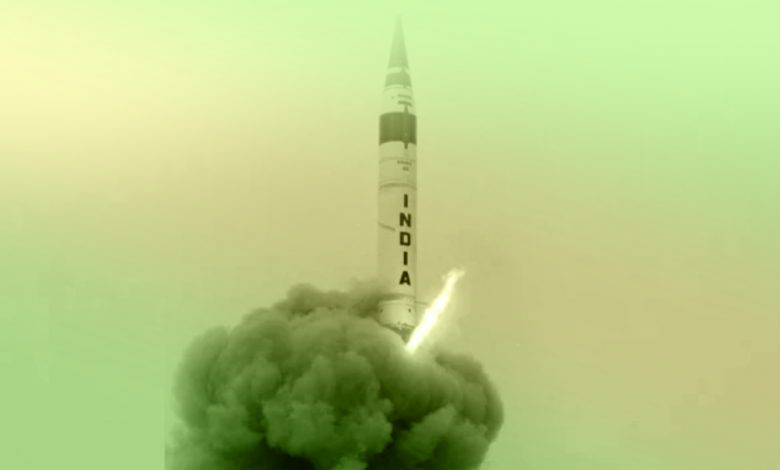Daily Current Affairs for UPSC
Agni-V ballistic Missile

Topic- Defence Technology [GS Paper-3]
Context- Recently India has successfully test-fired nuclear-capable ballistic missile Agni-V .
Key Highlights
- Agni-V ballistic missile is an ingeniously built advanced surface-to-surface ballistic missile developed under the Integrated Guided Missile Development Programme (IGMDP).
- It has a three-stage solid-fuel engine and can strike targets with a high degree of precision at distances up to 5,000 kilometres. Agni-5 can cover a range of even 8000 kms.
- The missile can reach an exceptional Mach 24 speed and also has a very high degree of accuracy to hit targets.
Significance
- The Agni-V project was built with an objective of boosting India’s nuclear deterrence against China which is known to have missiles like Dongfeng-41 having ranges between 12,000-15,000 km.
- The missile can bring almost the entire Asia including the northernmost part of China as well as some regions in Europe under its striking range.
No First Use Commitment
- The successful test of Agni-5, according to the Defense Ministry, is in accordance with India’s policy of having “credible minimum deterrence,” which supports the commitment to “No First Use.”
- This comes days after Indian and Chinese troops clashed in Tawang district of Arunachal Pradesh, an incident which became the topic of a major debate in Indian Parliament.
Agni Class of Missiles
-
- These missiles are the mainstay of India’s nuclear launch capability.
- The term Agni means “fire” in Sanskrit, and its meaning is understood in the context of Agni being one of the Pancha Mahabhutas or the five basic elements. Other elements are Prithvi (Earth), Aapa (Water), Wayu (Air), Akash (Space).
- Range of these missiles
-
- Agni I: Range of 700-800 km.
- Agni II: Range more than 2000 km.
- Agni III: Range of more than 2,500 Km
- Agni IV: Range is more than 3,500 km and can fire from a road-mobile launcher.
- Agni-V: It is the longest of the Agni series, an Inter-Continental Ballistic Missile (ICBM) with a range of over 5,000 km.
- Agni-P (Prime) is a canisterised missile with a range capability between 1,000 and 2,000 km. It will replace the Agni I missile.
- Very few countries, including the US, China, Russia, France and North Korea, own InterContinental Ballistic Missiles (ICBM).
Integrated Guided Missile Development Programme (IGMDP)
- The Integrated Guided Missile Development Programme (IGMDP) was conceived by Dr. A P J Abdul Kalam to enable India attain self-sufficiency in the field of missile technology.
- The missiles developed under the programme include
- Short-range surface-to-surface ballistic missile (Prithvi)
- Intermediate-range surface-to-surface ballistic missile (Agni)
- Short-range low-level surface-to-air missile (Trishul)
- Medium-range surface-to-air missile (Akash)
- Third generation anti-tank missile (Nag)
- The Agni, which was initially conceived as a technology demonstrator project in the form of a re-entry vehicle, was then upgraded to a ballistic missile with different ranges.
India’s Nuclear Triad
- Nuclear Triad essentially has three major components-the strategic bombers, Inter Continental Ballistic Missiles (ICBMs) and Submarine Launched Ballistic Missiles (SLBMs) in order to delivering a nuclear weapon.
- The reason for having such three branches capability is to reduce the possibility of the destruction of the entire nuclear architecture of the state in the first nuclear strike by the enemy itself.
- The triad also provides the potency to the country which has been under the nuclear attack to respond swiftly by nuclear means.





.png)



